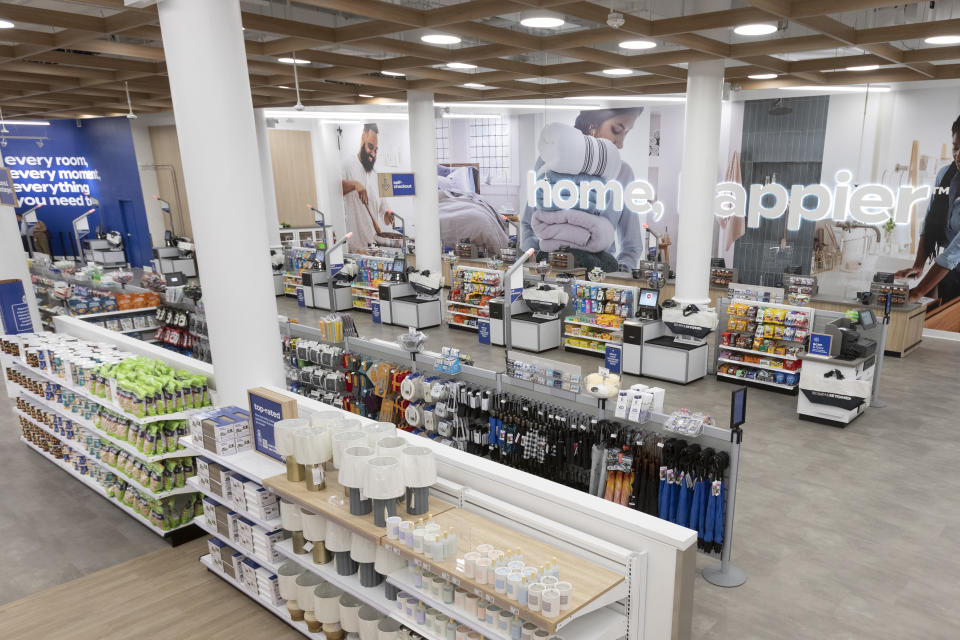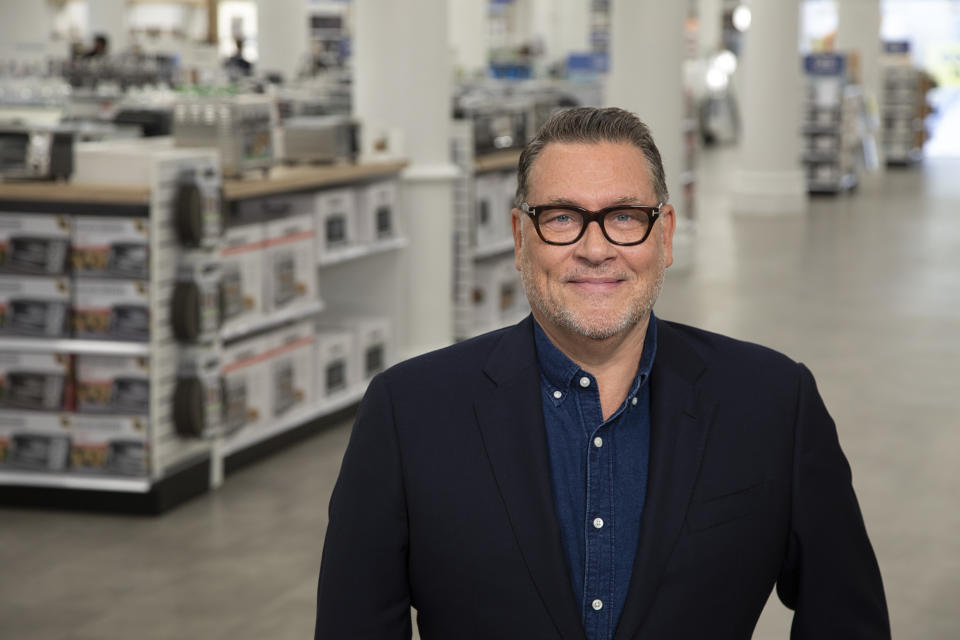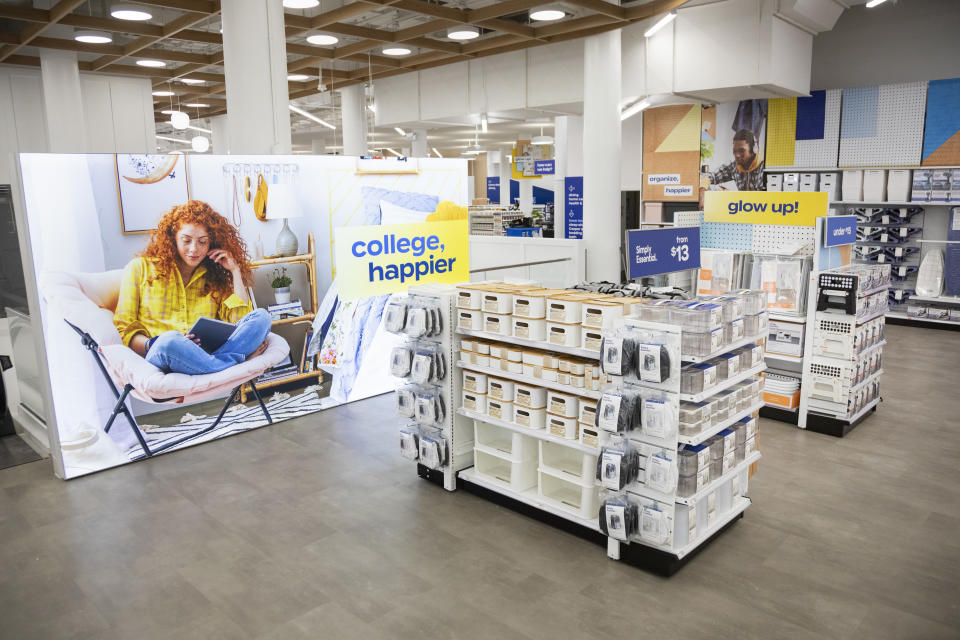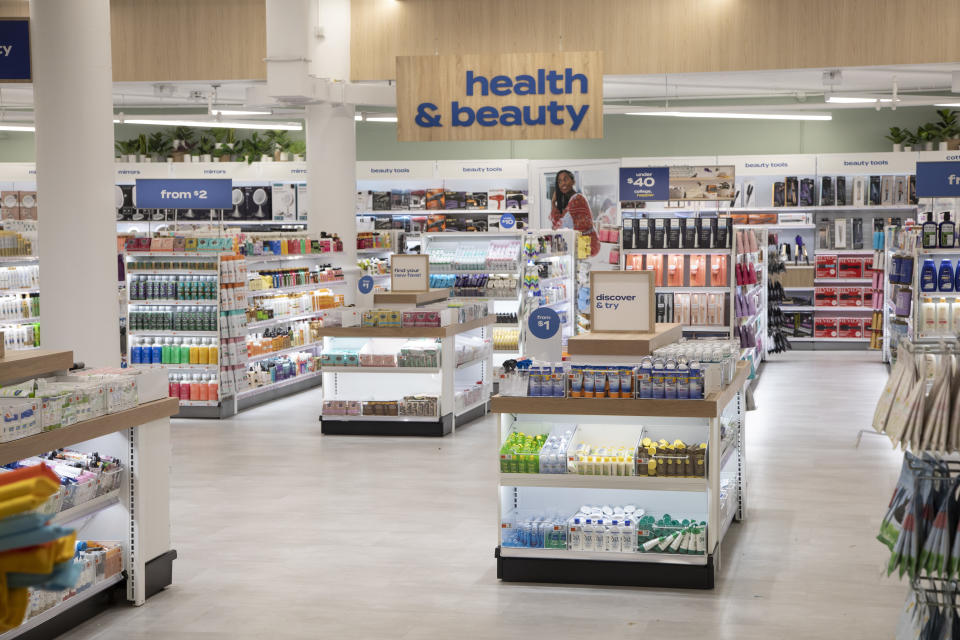Bed Bath & Beyond Takes Its Flagship to Another Dimension

NEW YORK — Standing in the bedding department of the totally transformed Bed Bath & Beyond flagship in Manhattan, Mark Tritton, president and chief executive officer of the retailer, asks, “Anybody remember what it used to be like down here? It was like a dungeon.”
He’s in high spirits as he leads a media tour previewing the two-level, 92,000-square-foot flagship, at 620 Sixth Avenue and 19th Street in the Chelsea neighborhood. It’s been under wraps since last December when the reconstruction began, and it reopens for business on Thursday.
More from WWD
The 30-year-old store was infamous for “shopper paralysis” — being about as unnavigable as retail brick-and-mortar can get. “It had a warehouse feeling with merchandise jammed to the ceiling,” Tritton said Tuesday.
But who would know it now, given all the upgrades, new merchandising formats, elevated displays and technology advances to the site. The shelves have been lowered, vistas are extended so shoppers can see across the store, aisles are wider, there’s bolder signage, and floor-to-ceiling windows were installed, enabling natural light to filter in.

Rob Tannenbaum
There’s a clearer demarcation of Bed Bath & Beyond’s destination categories: bed, bath, kitchen and dining, indoor decor, health and beauty, and organization, and perhaps most importantly, a relative ease of shopping that was lacking before. Tritton said there’s been a 40 percent reduction in stock keeping units, and a 14 percent reduction in square footage.
“The key word here is curation. You’re shopping for ideas, rather than items.” That would be design ideas for, as examples, dressing up the bed, the bathroom, setting the dining table or providing college-bound kids with dorm room necessities.
Quite noticeable is the spread of new Bed Bath & Beyond-owned brands, which the company has been aggressively rolling out. This year alone at least ten owned brands are being introduced simultaneously with efforts at eliminating product redundancies and unproductive skus.
Among the introductions so far: Simple Essential, the most basic owned brand in the portfolio, and Haven, a modern spa-inspired line for towels, bathrobes, bath rugs, shower curtains, bathroom furniture and storage solutions. Owned brands (Bed Bath & Beyond officials shun the term “private labels”) cover much more of the selling space now, and they’re prominently positioned, though high-profile market brands with national distribution like Uggs, Frette, Dyson and Keurig maintain a greater percent of the business.
Tritton wouldn’t specify the space occupied by owned brands in the flagship, though in terms of volume, owned brands represented 10 percent last year, and the goal is for 30 percent penetration within three years. How much owned brands comprise of the selling space at the flagship and other Bed Bath & Beyond stores will adjust as customer response is gauged.

Rob Tannenbaum
There’s a strong value play. Signs flagging bargains are sprinkled throughout: Simply Essential textured place mats, at two for $5; Windermere polished flatware at $1.99 for a spoon, fork or knife; compact pods of Nivea moisturizing cream for 99 cents.
But shoppers can also find Roomba robotic vacuum cleaners, from a couple of hundred dollars up to over $1,000, and there’s the first Casper shop-in shop, with moderately priced mattresses being offered along with other Casper sleep products. Additional Casper shops are being opened inside certain other Bed Bath & Beyond locations across the U.S.
“We’ve set out a bold strategic plan last October to become a digital first, omni-always retailer,” said Tritton, referring to the Bed Bath & Beyond transformation strategy he unveiled back then to turn around the business that generated $11.16 billion in sales in 2019 and $9.23 billion in 2020. Bed Bath & Beyond has struggled with eroding value perceptions, difficult to shop stores cluttered with redundant merchandise and poor signage, and intense competition from Amazon, Target and Walmart. But things are changing.
Along with bolstering owned brands, investments in technology and omni capabilities, the supply chain and the store experience are being made through an investment of $1 billion to $1.5 billion through 2023. The transformation strategy also entails 200 store closings; divesting non-core businesses such as Cost Plus World Market, which was sold off last December, and curtailing the omnipresent 20 percent off coupons known as “Big Blue.”
By 2023, Bed Bath & Beyond hopes to attain mid-single-digit comparable store sale gains, and operating profits of $1 billion.
The transformation plan has already been bearing fruit, with improved first-quarter selling trends reported, gross margins on the rise, and Tritton claiming Bed Bath & Beyond making market share gains. He also raised the outlook for the year with adjusted operating profits projected at $520 million to $540 million, up from $500 million in an earlier projection.
“A key component of our plan is modernizing our stores,” Tritton said. “The flagship is the penultimate expression.”
So far, 28 Bed Bath & Beyond stores have been renovated, which Tritton, the former Target chief merchant, characterized as “modified versions” of how the flagship has been upgraded. The plan is to modernize about 150 stores annually over a three-year period, at a cost of $250 million. Those 450 stores represent about 65 percent of total revenue.
Among the other innovations at the Chelsea flagship, there’s a SodaStream Bubble Bar whereby shoppers can personalize SodaStream bottles and buy SodaStreams Co2 cylinders, and mixologists will provide demos and drink ideas. There is also an area to try out vacuums, to see how loud they sound and how well they clean.
On the 19th Street side, an entrance has been created leading to the Café 3B, a new concept where a barista serves La Colombe coffee and pastries and other food and drink items are sold.
Among other features: a huge coffee department with a demo area; a wall of mirrors, and rotating seasonal shops, such as one geared for what college students need for their dorm rooms, like storage containers, coffee makers and other small appliances.

Rob Tannenbaum
On the technology/omni front, customers can set the Bed Bath & Beyond app to an in-store shopping mode to scan QR codes on the products, learn all about them and purchase them via their mobile phones as they continue to shop, thereby skipping the checkout line. Shoppers show the receipt on their phone to an associate as they exit the store. The QR codes create “endless aisles” to shop for additional colors, sizes and products that might not be displayed on the selling floor.
The flagship has a dedicated area to pick up online orders, or an associate will meet a customer outside for curbside pickup, all within one hour of placing the order. There are also expanded self-checkout and manned checkout areas. Bed Bath & Beyond has discovered that the majority of its shoppers in New York prefer self-checkout. The flagship has also extended its same-day delivery service to all of Manhattan.
“The store is organized by rooms,” said Joe Hartsig, Bed Bath & Beyond’s chief merchandising officer, who was one of several senior executives accompanying Tritton on the tour. Hartsig said Bed Bath & Beyond is the type of store where people come in for things they need and leave with things they didn’t know they needed.
“We are really trying to clarify the offer to our customers,” Hartsig said. “We’ve definitely curated our assortment and taken a lot of skus out.”

Rob Tannenbaum
Sign up for WWD's Newsletter. For the latest news, follow us on Twitter, Facebook, and Instagram.

 Yahoo Finance
Yahoo Finance 